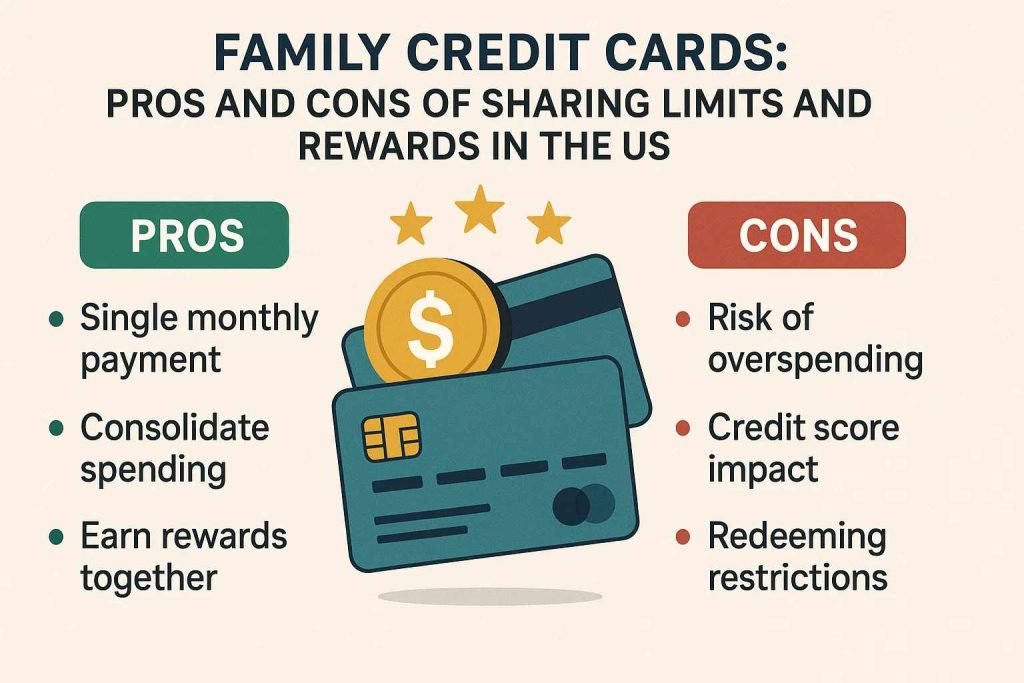In today’s modern financial landscape, credit cards have become an integral tool for managing expenses. When it comes to families, the idea of sharing a credit line by using family credit cards can be both beneficial and risky.
Understanding how to optimize these financial instruments can lead to significant rewards, but mismanagement can also result in pitfalls. In this post, we will explore the pros and cons of sharing credit limits and earning rewards collectively within a family unit in the United States.
The advantages of shared family credit cards

Family credit cards offer the potential for increased reward points, boosting financial benefits for the entire household. By concentrating expenditures on a single account, families can accumulate points or cash rebates faster than if each member held separate accounts. This consolidated expenditure can lead to gaining travel rewards, gift cards, or cashback more efficiently, driving extra value from everyday purchases.
In addition to rewards, shared credit lines can simplify managing family finances. Having a single monthly statement provides a comprehensive view of spending habits, which can help families identify unnecessary expenses and improve budgeting. Moreover, sharing a credit card might help parents build their children’s credit history, giving them a head start towards a positive financial future.
Boosting rewards through collective spending
Maximized spending on a shared credit account often leads to quicker accumulation of reward points. When each family member uses the same card for their purchases, the reward potential significantly increases. Many card issuers offer bonus categories like groceries and dining, which are commonly high-spend areas for families.
Moreover, some credit cards offer annual bonuses or incentives if certain spending thresholds are met. With combined spending, achieving these thresholds becomes more feasible, further enhancing the family’s reward earnings. Families should explore different reward programs to select the one which aligns best with their spending habits, ensuring they get the most value out of their joint efforts.
The drawbacks of shared credit limits
Despite the appealing benefits, sharing credit limits has its perils. A major concern is the potential for overspending, as multiple individuals have access to the same credit pool. This can lead to high credit card balances, which, if not managed prudently, might result in debt accumulation. It is essential to communicate spending limits and responsibilities clearly amongst family members to prevent financial strain.
Credit utilization rate, a crucial factor in credit standing, can also be adversely affected. If the collective spending approaches the card’s limit, it can negatively impact the family’s credit score. Moreover, any late payments on a shared card will equally affect all users associated with that account.
Practical strategies to manage shared credit responsibility
Establishing thorough communication about financial responsibilities is vital for families sharing credit. A good practice is setting a budget for each member to help monitor expenses. Regular meetings to review the monthly statements can also foster accountability and assist in maintaining financial discipline.
For those starting out, opting for a credit card with customizable spending alerts can be beneficial. This feature allows users to receive notifications when spending nears agreed limits, acting as an early warning system. Incorporating these practices can help families enjoy the benefits of shared credit cards while remaining financially sound.
Final thoughts on family credit card management
Credit cards can be a powerful tool for families, offering the chance to earn rewards and build credit history together. However, clear communication and strategic planning are essential to maximize these benefits. By setting mutual goals, establishing spending limits, and regularly reviewing financial habits, families can successfully navigate the challenges.
Ultimately, family credit cards can be a double-edged sword. They offer a path to shared financial growth and efficiency but require cautious management. With careful use, they can enhance financial well-being and create opportunities for families to enjoy rewards together.
